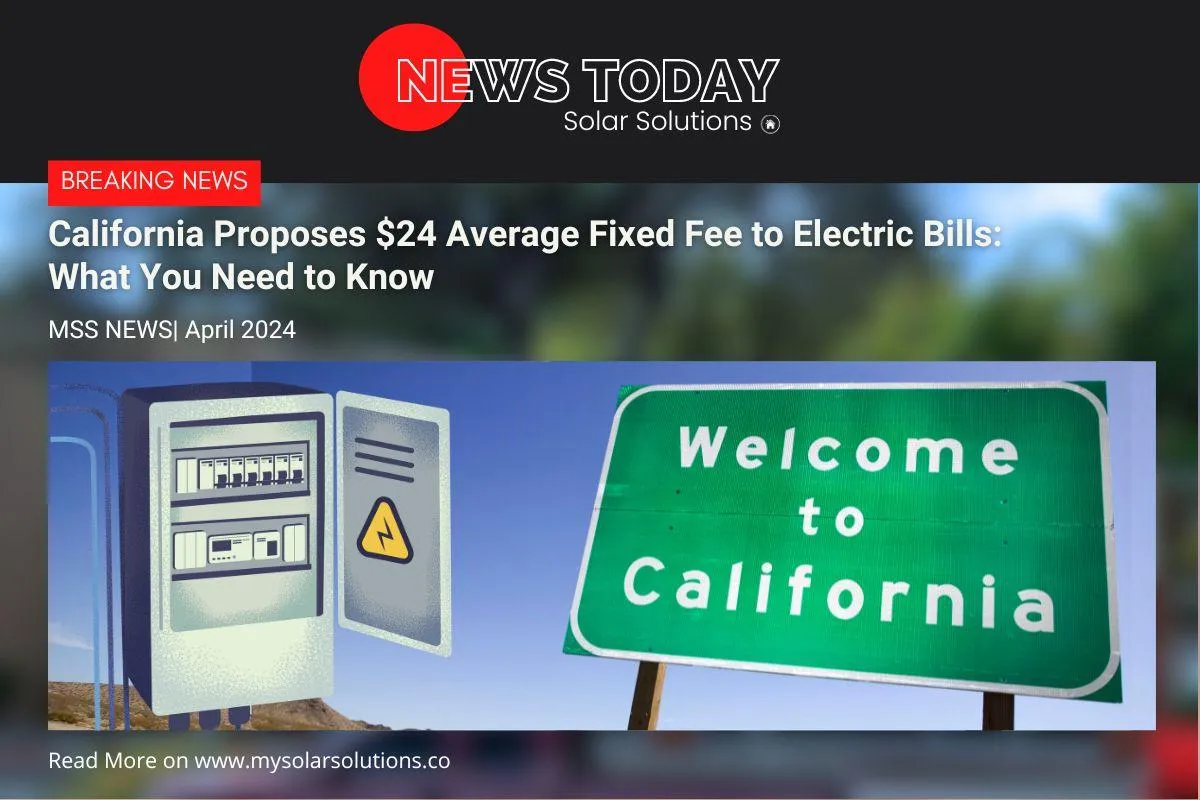NEWS
BREAKING NEWS

California Proposes $24 Average Fixed Fee to Electric Bills: What You Need to Know
In a move to address the growing electricity affordability crisis in California, the California Public Utilities Commission (CPUC) has proposed a decision that could have a significant impact on customers' electric bills. The proposal includes the implementation of a $24.15 monthly fixed charge on customers of Pacific Gas & Electric (PG&E), Southern California Edison (SCE), and San Diego Gas & Electric (SDG&E). Additionally, the proposal suggests reducing the volumetric rates by approximately 5 to 7 cents per kilowatt-hour. Let's delve deeper into the details and implications of this proposed decision.
Decoupling Energy Use and Grid Maintenance Costs
One of the motivations behind the CPUC's proposed decision is the need to decouple energy use and grid maintenance costs. The current electric rate structure penalizes households that have less control over their electricity use, such as those living in hotter regions or with more residents under one roof. These households end up paying more than their fair share of costs that do not vary by usage, such as utility customer service, energy efficiency programs, and activities related to providing basic service.
Variable Monthly Electricity Charge Based on Customer Income
The proposed fixed monthly charge varies based on customer income levels, with the lowest income bracket being offered a substantial 75% discount. The average recommended charges for PG&E, SCE, and SDG&E are $23.25, $24.52, and $25.62, respectively. This variable pricing strategy aims to ensure that low-income households are not burdened with excessive utility charges.
Lowered Volumetric Rates vs. Recent Rate Increases
While the proposed decision reduces the volumetric rates by five to seven cents, it is important to note that recent rate increases have essentially negated this discount. PG&E, in particular, approved a 13% rate hike in 2024. Despite the proposed reduction, rates are still expected to be significantly higher compared to previous years.
Escalating Peak Demand Electricity Rates
Peak demand electricity rates in PG&E are currently exceeding $0.62 per kilowatt-hour, and industry experts anticipate these rates will continue to skyrocket. There is increasing concern regarding the impact of these rising rates on energy affordability for consumers in California. The urgent need for reform is evident, as over 20% of customers in the state's three largest utilities are over a month late on their electricity bills. In the low-income brackets, this number rises to a staggering 33%.
Potential Pitfalls: The Uncapped Fixed Charge for Homeowner's Energy Bills
Opponents of the proposed decision are raising apprehension about the risk of an uncapped fixed charge. They argue that allowing utilities to affix ever-increasing fees to residents in their territory could lead to significant financial burdens. A coalition of over 240 environmental justice, climate, renter, housing, and community groups stands firm in opposing this proposal, warning that what may seem like a $24 charge today could easily become $80 in the near future.
Implications for Rooftop Solar Customers
One specific group that may feel the impact of the proposed fixed fee and reduced volumetric rates are rooftop solar customers. A higher fixed fee and a lower volumetric rate generally translate to fewer possible savings on monthly costs for these customers. However, the CPUC spokesperson has assured that the proposed decision will not have a substantial negative impact on rooftop solar economics. Payback periods for existing solar customers are expected to remain under five years, with rates continuing to send appropriate price signals through time-of-use rates.
The proposed decision by the California Public Utilities Commission aims to address the electricity affordability crisis in California by introducing a $24.15 monthly fixed charge and reducing volumetric rates. While the proposal aims to be fairer towards low-income households and decouple energy use from grid maintenance costs, there are concerns regarding the potential for uncapped fixed fees. The impact on rooftop solar customers is also a point of contention. As the proposal moves forward, it is essential to consider the long-term implications for energy affordability and the overall transition to a sustainable energy future.
FAQs
1. Will this proposed decision lower my electricity bill in California?
While the volumetric rates are reduced by approximately 5 to 7 cents per kilowatt-hour, recent rate increases may offset any potential savings. The impact on individual electricity bills will vary based on your energy consumption and the utility company you are subscribed to.
2. How will the proposed decision affect low-income households?
The proposed fixed charge includes variable pricing based on customer income levels. Low-income households are offered a substantial 75% discount on the fixed charge. This approach aims to minimize the burden on vulnerable communities.
3. What are the concerns regarding the uncapped fixed charge?
Opponents of the proposal worry that an uncapped fixed charge might lead to ever-increasing fees in the future. This could pose a significant financial burden on residents in utility territories. Advocacy groups are calling for legislation to place caps on fixed fees for low-income Californians.
4. Can rooftop solar customers expect higher costs?
Rooftop solar customers may experience reduced monthly savings due to a higher fixed fee and lower volumetric rates. However, the California Public Utilities Commission reassures that the impact on solar economics will be minimal, with payback periods for existing customers remaining under five years.
5. How will this decision impact California's transition to renewable energy?
The proposed decision seeks to maintain fairness in electricity billing while addressing the affordability crisis. It is crucial to strike a balance between sustainability and ensuring energy costs remain reasonable for all customers. As such, the long-term impact on California's clean energy transition is yet to be determined.

